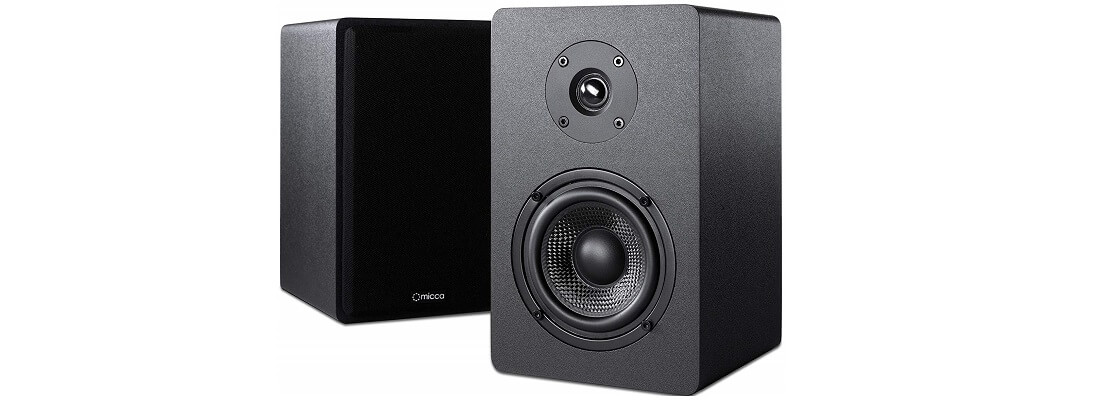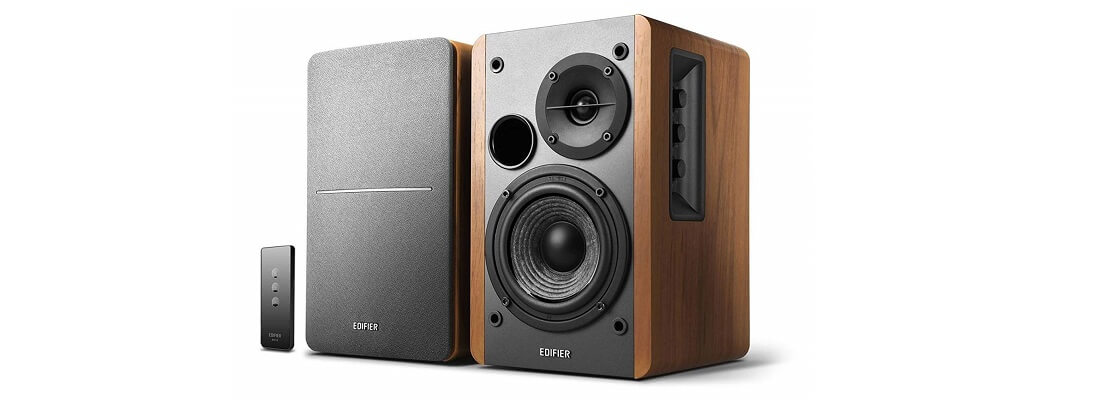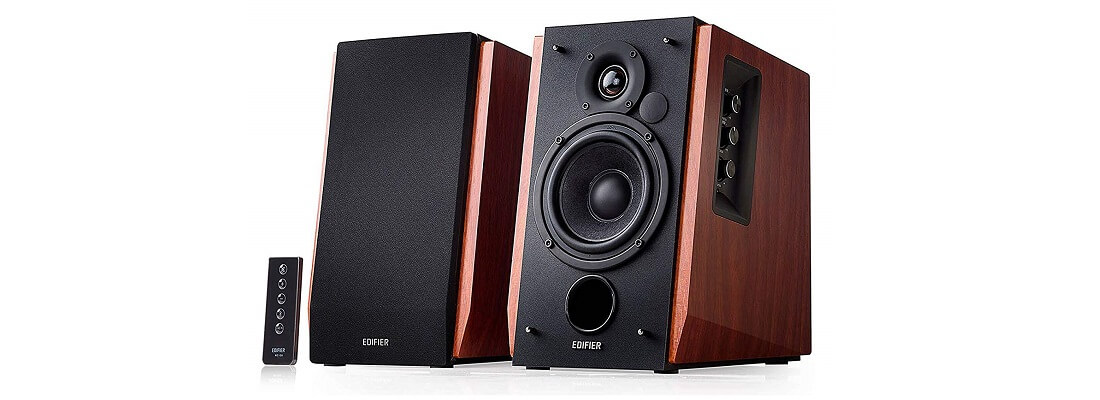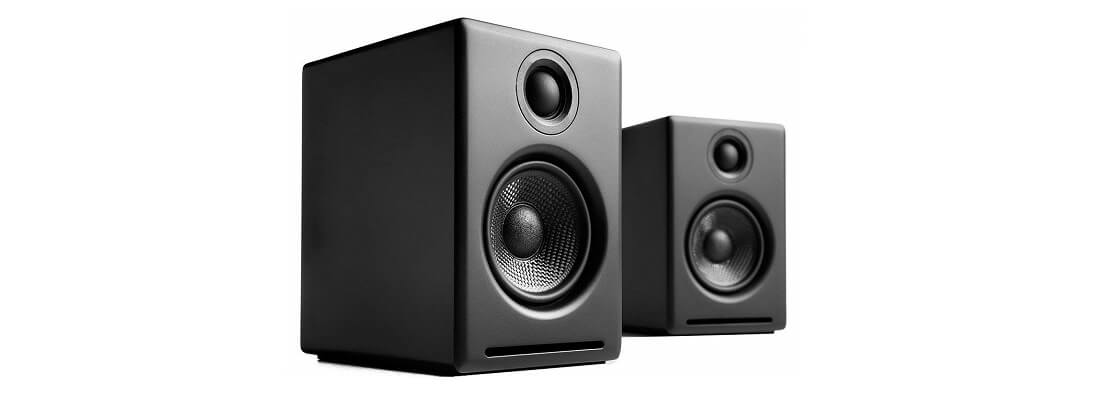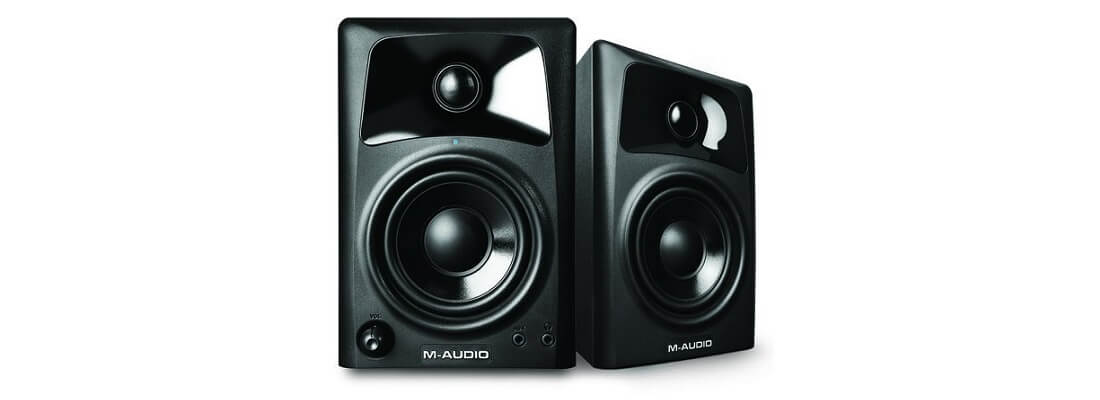Picking a speaker that meets individual environment, budget, and space requirements is not a challenge when you have a full knowledge of the best powered bookshelf speakers, their features and specs.
First, they are compact to save space but may need subs to enhance low-frequency response. Powered speakers are rather versatile: they are being used as fronts, rears, or surrounds. They can be placed not only on the bookshelf but also on an open space or speaker stands, or be fixed to the wall.
There are two types of this equipment on the market – passive and self powered bookshelf speakers. Even though passive bookshelf speakers tend to perform better in some cases, the latter ones have built-in amps to escape installing receivers in order to make a compact system. EQ settings, crossover to filter the signal, and microphone preamps are also included. Moreover, they can even accept wireless signals. It’s a proper solution for turntable setups or improving the TV audio.
Such speakers are easy to use. Just power them or use a battery and make a connection between speakers and a vocal microphone, a guitar, a record player, an MP3 player, or any other device.
Passive models need wire connection and they are usually lightweight. They have no built-in amps that means the purchase of external one to hook it up to the speaker and upgrade its performance. To choose the compatible amp is crucial in this case (power ratings and respective impedance should be considered).
If it is difficult to take the final decision – which type of speaker to choose, read the article about the best bookshelf speakers.
The Best Powered Bookshelf Speakers Reviews
Micca PB42X – Durable and Stylish Construction
This model is not tiny – 9.5″ x 5.8″ x 6.5″ – and produces 15W of clean power per channel amplifier and is able to operate with a 24V/5A power supply. The high-quality amp is developed on a newer Texas Instruments Class D amp chip. The lack of built-in wireless tech (Bluetooth, Wi-Fi, or Airplay) requires an additional amplifier or AVR to power the speakers, along with an audio source (CD player, for example) or Bluetooth audio receiver.
The unit can be hooked up from the receiver’s headphone out to the RCA inputs on the amp on the back, to onboard computer sound, or to an external DAC. It is designed with a classic tweeter, a 4-inch woofer, a crossover on the back and it has a magnetic black grill. Rounded edges, faux wood grain finish, and the laminate attached on all sides make it look stylish. Its building is sturdy due to binding posts for connecting speaker wire.
It can be called the best powered bookshelf speaker despite the drawbacks below because it delivers warm midrange with decent bass that could be enhanced via a sub.
Pros
- No rattling when playing at higher volumes.
- Clear sound, no distortions.
Cons
- Light cabinet tends to resonate at higher volumes.
- Some spikes and dips are audible in the lower ranges from 128Hz to 800Hz. The additional software is required to solve the issue.
Edifier R1280T – Well Made and Balanced to Sound Great
The pair of speakers has 5.75″ x 9.5″ x 7″ dimensions, and it is developed to upgrade PCs and laptops’ audio. 3.5mm adapter is required to connect smartphones.
They come with 4-inch primary woofers and a separate tweeter in each unit, 2 RCA audio inputs for fast and simple connection. Both inputs are always active to avoid switching them along with the monitor or using a more complicated cable setup. The buttons to calibrate volume, treble, and bass are on the right speaker. The speakers have a removable cloth panel.
It can become one of the best powered bookshelf speakers due to its building, but it doesn’t perform perfectly regarding the power. It allows creating a good listening environment in a small room, but it needs a sub or drivers for larger spaces. The unit produces clear midrange and highs but delivers bass with a tad distortion when the volume is maximum. Half of its maximum is enough to escape this flaw. The highs and lows could be more powerful.
Pros
- Good balance between right and left speakers.
- Both Bluetooth receiver and TV can be connected due to two inputs.
Cons
- On the remote, there are no buttons to adjust treble and bass.
- Not compact for a desktop setup, especially with a sub connected.
Edifier R1700BT – Clear Sound at All Volume Levels and Frequencies
The speakers (6″ x 8″ x 9.75″) come with built-in Bluetooth (works without lags) to be hooked up to plenty of devices (phone, tablet, PC, gaming console, and TV) and provides high-quality sound both for stereo systems and home theaters. They are designed with an angle to direct sound straight to the ears.
Its design looks classic with wood finish. Its 19mm dome tweeter and 4-inch bass driver do their job to provide deep natural tones with clear highs. I’m personally ready to recognize it as the best powered bookshelf speaker turning a blind eye to the lack of bass response that is rather typical for all bookshelf units and can be adjusted via a sub.
The speakers have Digital Signal Processing and Dynamic Range Control techs, as well as good channel separation to exclude distortions and provide absolute clarity irrespective of musical genres and content (music, audiobooks, etc.). Their 5-pin connector allows connections with passive speakers to get deeper bass.
Pros
- No distortion up until max remaining good separation vocals from instruments.
- The clarity of sound is the same whether the streaming is from computer or TV.
Cons
- No way to turn Bluetooth off in the speaker that makes the occasional connections with other people’s devices possible. In this case, the audio signal will be interrupted.
- The Bluetooth should be switched off on the phone before watching TV via Bluetooth connection.
Audioengine A2+ – Great Connectivity, Decent Sound
These best powered bookshelf speakers reviews cannot do without ultra-small (4″ x 6″ x 5.25″) Audioengine A2+ with a painted white or black finish for its cabinet. It is designed with a tweeter and woofer in the center of the front panel. The kevlar woofer has a sturdy building, but it has just 2.75 inches in diameter. The slot port is on the front too that allows placing speakers close to the wall. The unit comes with 1/8 inch jack to connect portable sources and 2 RCA ports to hook up a CD or a record player.
The Audioengine A2+ has a solid bass response that is not typical for bookshelf speakers in this price range. The speakers work best of all when being hooked up to the computer, but the quality of sound is being degraded when connecting them to the other sources. The treble is a bit harsh, but the sound has no audible distortions in general at medium volume.
Pros
- If I place them in the corner, they are able to reach the 48Hz.
- The option to control volume via both built-in and external preamps.
- The USB port to connect diverse devices with 3.5 mm AUX.
Cons
- The bass honks at high volumes.
- Need good stands when positioning them in the desk to connect to the comp that will allow directing the sound in the right way. It’s crucial because the sound of speakers depends on direction.
M-Audio AV32 – Top-notch Building for Good Audio
The speakers’ dimensions are 7.5″ x 5.1″ x 6.1″ and the manufacturer claims that the woofer is 3″ in diameter. In fact, it is even larger and can boast 3.5″ that is a pleasant surprise and a reason for placing this unit among the best active bookshelf speakers. However, the model lacks the turn on/off button on the front, but it comes with a dip switch on the back to be turned on automatically after it detected music. The M-Audio AV32 has the input for headphones on its front panel to connect them in a second.
The speakers’ construction contributes to the sound quality in important ways. The tweeter is placed in a large and the OptImage IV waveguides to expand its reach. The woofer has its own thick waveguide. The speakers can start at 20 kHz and drop down to 80Hz. The thoroughly structured waveguide also provides extended bass and clear highs.
Pros
- The speakers come with speaker wire and all the necessary connectors.
- The speakers can get loud enough to fit home amateur studio.
Cons
- There is only one powered speaker.
- The speakers are tiny and need very high stands for the directional adjustment that is not aesthetic.

